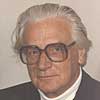Konrad Zuse
|
|
|
 Konrad Zuse principal papers hardware software
keywords see also related subjects |
Achievement One of the originals during World War II. Developed the Z1 one of the first computers with a stored program mechanism.
Biography Konrad Zuse was born in Berlin in 1910. In his early years he studied civil engineering at Technische Hochschule Berlin-Charlottenburg and began his working career as a design engineer in the aircraft industry. Zuse soon learned that one of the most difficult aspects of doing a large calculation with either a slide rule or a mechanical adding machine is keeping track of all intermediate results and using them in their proper place in later steps of the calc ulation. His first idea was to design a series of special forms which a calculation could be done without the possibility of confusing intermediate results. These forms contained preprinted in boxes which numbers could be written; boxes horizontally adj acent should have contents multiplied together, while those boxes vertically adjacent would have contents added. Here is how the concept works. His thinking about the design of these calculating-plan forms soon led him to the realization that, if the numbers were entered into a mechanism which could link together mechanical calculators in the way indicated by his forms, then the calculations could be done automatically. Next Zuse's ideas involved his consideration of a device which would have an arm capable of moving over the serface of a table, much like today's flatbed plotters. This arm would be used to read and write numbers, in the form of punched cards, into the various boxes, of Zuse's calculating-plan forms. The arithmetic was to be done by a mechanical calculator while the movement of the arm was to be controlled by a mechanism which would be following a series of coded instructions from the calculating-p lan form. Zuse suddenly realized that, once you had the instuctions coded for the control mechanism, there was no longer any need for the calculating-plan form at all and it had become nothing more than a series of boxes acting like a memory. Thus, by 1934, Zuse had realized that an automatic calculator only required three basic units: a control, a memory, and a calculator for the arithmetic.
Chronology
Honors and awards
|
![]()
| Last Updated on June 16, 2003 | For suggestions please mail the editors |
Footnotes & References
| 1 |
| 2 |
| 3 |
| 4 |